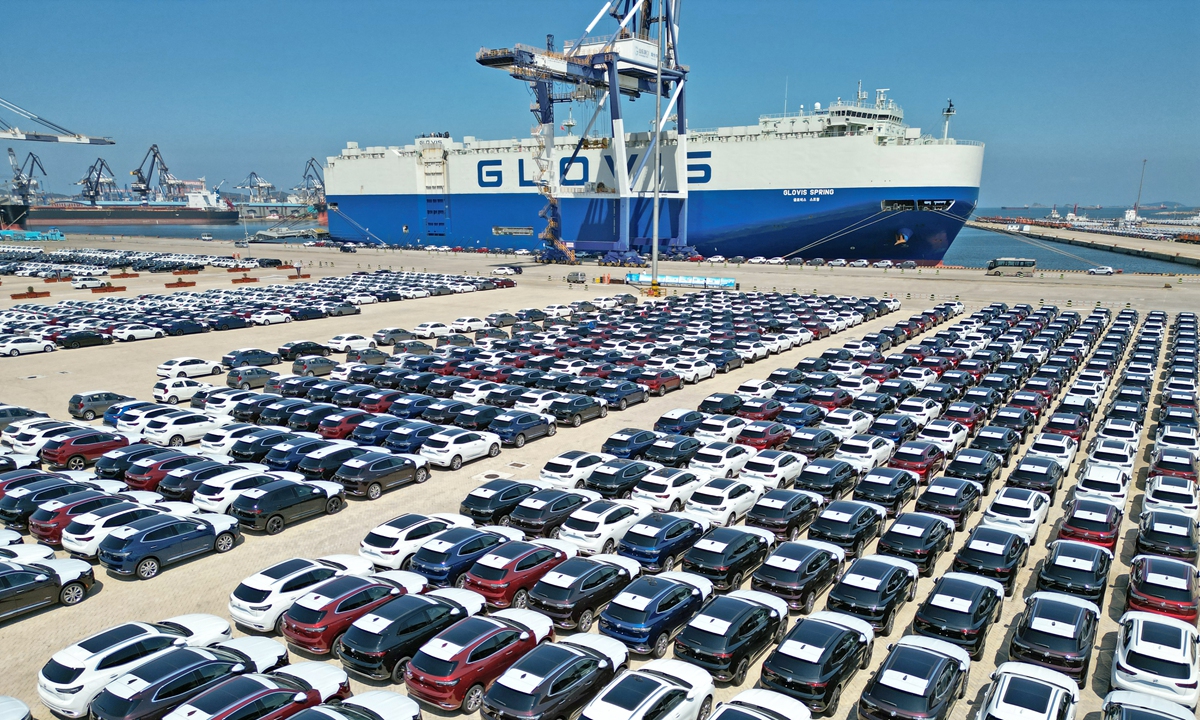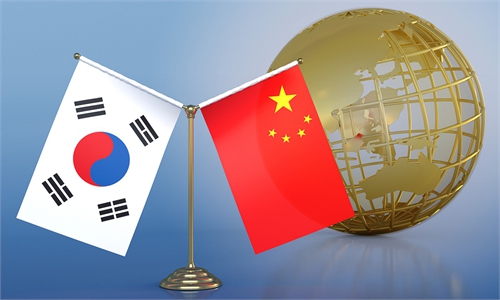China’s trade prowess shrugs off West’s cliché 'threat theory;' hype can’t deny China’s contributions in global supply chain

A large number of vehicles are arranged at a port in Yantai, East China's Shandong Province, waiting to be loaded and shipped to overseas markets, on August 17, 2022. Photo: VCG
As China's export machine kept roaring and actually gained more share of global trade over the past three years during the COVID-19 pandemic against multiple headwinds, including a relentless US decoupling push, some US and Western officials and media outlets have in recent weeks stepped up warnings of "overreliance" on Chinese exports, in what appears to be a fresh, coordinated attempt to expand their long-standing, ill-intended "China threat" theory.Chinese analysts dismissed the new attempt as "old wine in new bottle," as the US-led West has long been peddling the "China threat" theory to no avail, noting that such claims reflect their growing frustration over China's resilience, ignore the positive contributions of Chinese exports in the global fight against COVID-19, distort basic trade and economic rules and are based entirely on ideological bias and geopolitical self-interests.
China's continued rise in global trade is the result of the inherent resilience of the Chinese manufacturing sector, the effective pandemic response that helped minimize the economic fallout of the virus, as well as policy measures to stabilize trade and the economy, analysts noted.
Such advantages will continue to underpin the rise of the world's biggest trading nation in the foreseeable future, despite intensifying fear-mongering by Western politicians and media outlets in their attempt to isolate China, they said.
'Old wine in new bottle'
As their repeated "China collapse" predictions collapsed, many Western politicians and media outlets have shifted focus onto China's growing global trade share during the pandemic and resorted to "China threat" theory by warning of the danger of "overreliance" on Chinese exports.
The trend was particularly clear over the past week or so. In a report on Sunday, the Wall Street Journal said that the pandemic boosted China's position as the world's manufacturer, concluding that "the West relies on Chinese factories, despite national-security [and] supply-chain concerns."
On Friday, a Reuters report said the German economy became more dependent on China in the first half of 2022, which it says causes a "political problem" for Germany as China's stance on the Ukraine crisis and response to the Taiwan question placed German business with the world's second largest economy under scrutiny.
"The 'China threat' theory is nothing new. Its predecessor is the 'China collapse' theory, which turned into the current version. These theories are nothing but jealousy, or efforts to slander China," Gao Lingyun, an expert at the Chinese Academy of Social Sciences in Beijing, told the Global Times.
The US and other Western officials have long been peddling the "China threat" theory, including the fear-mongering about the "overreliance" on Chinese exports, as part of their broad strategic goal of containing China's rise by kicking China out of the global supply chain.
One of the most high-profile cases are remarks by US Treasury Secretary Janet Yellen during a trip to South Korea in July. Yellen called on US allies to boost their trade ties, in a bid to reduce dependency on China. She also touted what she described as "friend-shoring" - which refers to a push to build supply chains with US allies and exclude perceived rivals such as China.
While that phrase has been catching on, Chinese analysts insist that such rhetoric mostly reflects the anxiety among Western officials over their own economic crises as well as their failure to contain China's rise.
Hu Qimu, chief research fellow at the Sinosteel Economic Research Institute, said that the economic and social problems that are currently plaguing the US and some European countries like stagnation risks or lack of growth momentum are making some governments anxious, leading them to have an "imaginary enemy," which China fits well with its burgeoning industrial chains.
They also need an "excuse" to carry out economic sanctions against China, such as tariff policies or crackdown on Chinese tech companies, in order to snatch China's economic fruits or market share.
"For instance, when the Biden administration attempts to persuade other countries to remove supply chains from China, commercial reasons won't sound logic, and only glamorizing national security issues might make overseas companies think twice about the trouble of investing in China," Hu said.
Experts also stressed that the idea that China is a threat to global industrial chains reflects Western countries' jealousy toward China's rising status, as they can't view the maturing of China's industries from a neutral perspective.
Resilience during pandemic
One thing even anti-China Western officials and media outlets cannot ignore is that China's position as the bellwether of global industrial chains is not weakened, but has rather been strengthened in the past three years, reflected by China's rising share of global goods exports, especially products with high added values.
The WSJ report, for example, noted that China's share of global goods exports by value increased to 15 percent by the end of 2021 from 13 percent in 2019. In comparison, Germany's share fell from 7.8 percent to 7.3 percent during the period, while US' share slipped to 7.9 percent from 8.6 percent.
China's official data also showed that the country's exports recorded positive growth in 2020 and 2021 despite a series of challenges posed by the pandemic, US crackdowns and conflict in Europe. In 2020 and 2021, China's exports rose by 3.6 percent and 29.9 percent in US dollar terms, Chinese customs data showed.
In addition to robust growth in traditional Chinese exports such as manufactured goods, many high-tech products also saw rising exports in value in the past several years. For example, China's exports of integrated circuit products rose 32 percent in 2021 and 14.8 percent in 2020, according to the customs data. Imports also gained a rising trend. In the first seven months this year, China's imports rose 5.3 percent in US dollar terms.
Electric cars are also a good example. According to data revealed by Cui Dongshu, secretary general of the China Passenger Car Association, China exported 440,000 new-energy vehicles in the first seven months this year, compared with 588,000 in the whole year of 2021 and 223,000 in 2020, media reports showed.
Behind the steady rise of China's exports sector during the pandemic are various specific advantages of the Chinese system, analysts noted.
Qiu Wenxu, director of Industry Development Department at the Alliance of Belt and Road Business Schools, said that China's system of handling the coronavirus has given Chinese companies "comparable advantages during a special time."
"China's institutional advantages have enabled factories to remain stable production abilities, and China's reputation as world factory is gained through tests from the global markets," he told the Global Times.
Hu also noted that the coronavirus is a touchstone for global industrial chains, and China has survived the tests for its ability to maintain supply chain safety from external disasters, while many advanced economies such as the US faltered profoundly.
"In the past, many companies thought they could move supply chains away from China, but after the coronavirus crisis, they start to realize that they need to at least preserve some spare production capacity in China, because China is very likely to be the only market to withstand major sudden supply chain risks," Hu noted.
Unstoppable rise
Given such advantages of the Chinese economy, its global ascent will not be stopped by politically charged smearing and crackdown waged by the US and some of its allies, analysts noted, while calling for effective measures to counter potential hurdles.
In response to the so-called "China threat" theory and the intensifying crackdown campaign, experts stressed that China should stick to multilateralism and avoid straining the relationship with Europe and South Korea.
"The US has been creating small groups to increase the political dependence of other countries on it. But in fact, some members of the small circles of the US also have their own plans," Gao said.
Gao also said that China should take advantage of its market size and complete industrial chain to increase self-reliance and take control of its national security.
The country has laid emphasis on a dual circulation economic model in recent years with efforts launched to both stimulate domestic demands and attract overseas business orders.
So far this year, a total of 23 key domestic cities have launched consumption coupons to encourage spending after the country experienced coronavirus outbreaks in multiple cities, according to media reports.
Meanwhile, efforts to stabilize domestic economic activities, including in the manufacturing and exports sector, remain a top priority for the Chinese government. In the latest effort, the State Council, China's cabinet, dispatched 19 supervising teams to various regions to inspect the implementation of epidemic control and economic stabilization measures, highlighting China's unwavering effort to stabilize its economy.



